-
 Bitcoin
Bitcoin $113900
0.81% -
 Ethereum
Ethereum $3472
0.21% -
 XRP
XRP $2.898
1.45% -
 Tether USDt
Tether USDt $0.0000
0.04% -
 BNB
BNB $748.0
0.32% -
 Solana
Solana $162.1
0.13% -
 USDC
USDC $0.9999
0.02% -
 TRON
TRON $0.3256
0.52% -
 Dogecoin
Dogecoin $0.1989
1.70% -
 Cardano
Cardano $0.7255
3.59% -
 Hyperliquid
Hyperliquid $38.00
1.15% -
 Stellar
Stellar $0.4002
7.96% -
 Sui
Sui $3.422
1.21% -
 Chainlink
Chainlink $16.22
2.48% -
 Bitcoin Cash
Bitcoin Cash $540.4
1.98% -
 Hedera
Hedera $0.2466
6.42% -
 Ethena USDe
Ethena USDe $1.001
0.03% -
 Avalanche
Avalanche $21.39
0.66% -
 Toncoin
Toncoin $3.621
1.12% -
 Litecoin
Litecoin $109.5
0.60% -
 UNUS SED LEO
UNUS SED LEO $8.953
-0.07% -
 Shiba Inu
Shiba Inu $0.00001221
2.27% -
 Polkadot
Polkadot $3.589
2.06% -
 Uniswap
Uniswap $9.124
2.03% -
 Monero
Monero $294.4
0.24% -
 Dai
Dai $1.000
0.02% -
 Bitget Token
Bitget Token $4.322
0.76% -
 Pepe
Pepe $0.00001046
2.30% -
 Cronos
Cronos $0.1327
3.25% -
 Aave
Aave $257.5
1.79%
How to determine the price of Bitcoin ETF?
A Bitcoin ETF's price hinges on Bitcoin's market price, supply/demand, expense ratios, premium/discount to NAV, and regulatory factors; a perfect correlation is unlikely.
Feb 27, 2025 at 03:42 am
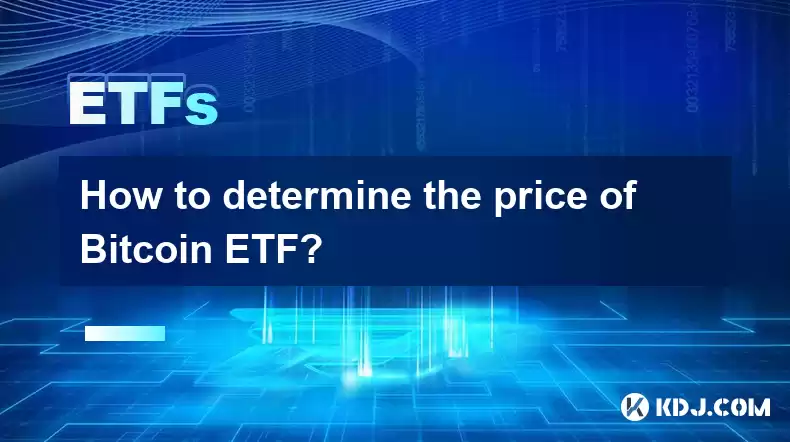
How to Determine the Price of a Bitcoin ETF?
Key Points:
- Underlying Asset Value: The primary driver of a Bitcoin ETF's price will be the market price of Bitcoin itself. However, the ETF's price won't perfectly mirror Bitcoin's price due to various factors.
- Supply and Demand: Like any other traded asset, the ETF's price will fluctuate based on the interplay of supply and demand within the ETF market itself. This includes investor sentiment, trading volume, and the overall market conditions.
- Expense Ratio: The ETF's expense ratio (fees charged to manage the fund) will subtly impact the price, as these fees are deducted from the fund's assets.
- Premium/Discount to NAV: The ETF's price may trade at a slight premium or discount to its Net Asset Value (NAV), which represents the value of the underlying Bitcoin holdings. This deviation can be influenced by market liquidity and investor sentiment.
- Regulatory Factors: Regulatory changes and announcements concerning Bitcoin and ETFs could significantly affect the price.
Determining the Price of a Bitcoin ETF: A Detailed Exploration
The pricing mechanism for a Bitcoin ETF is complex, involving several interconnected factors that influence its market value. It's crucial to understand that while the ETF aims to track the price of Bitcoin, several elements prevent a perfect one-to-one correlation.
- The Fundamental Role of Bitcoin's Market Price:
The most significant determinant of a Bitcoin ETF's price is the prevailing market price of Bitcoin itself. The ETF will hold Bitcoin (or Bitcoin futures contracts, depending on the ETF's structure) as its underlying asset. Therefore, any substantial price movement in the Bitcoin market will directly impact the ETF's value. This relationship is not always linear, however. A sudden, sharp increase in Bitcoin's price might not be immediately reflected in the ETF's price due to factors such as trading volume limitations, arbitrage opportunities, and the time it takes for the ETF to adjust its holdings to reflect the new Bitcoin price. Conversely, a sharp drop in Bitcoin’s price might cause a similar delay in the ETF price reflecting this decrease, particularly if there is a large influx of sell orders overwhelming the ETF's liquidity. Furthermore, the ETF’s pricing mechanism will also take into consideration the price of Bitcoin across various exchanges to ensure a fair representation of its value. Discrepancies between different exchanges can contribute to minor price variations between the Bitcoin spot price and the ETF’s price. This is particularly important during periods of high volatility where arbitrage opportunities may cause short-term divergences. Sophisticated algorithmic trading strategies constantly monitor price discrepancies and exploit these arbitrage opportunities, influencing the ETF's price to remain relatively close to the fair value of its underlying Bitcoin assets. The ETF manager’s strategies in managing the fund, particularly in relation to timing and execution of trades, can also have a minor impact on the price, even though the aim is to maintain a close tracking of Bitcoin’s price.
- The Dynamics of Supply and Demand within the ETF Market:
Beyond the underlying Bitcoin price, the ETF's price is also influenced by the standard forces of supply and demand within the ETF market itself. Investor sentiment plays a crucial role. Positive news regarding Bitcoin adoption, regulatory clarity, or overall market optimism can lead to increased demand for the ETF, pushing its price upwards. Conversely, negative news, regulatory uncertainty, or a general bearish market sentiment can trigger selling pressure, driving the price down. The trading volume of the ETF is also a key factor. High trading volume generally indicates a liquid market, making it easier for buyers and sellers to transact, thus minimizing price discrepancies from the underlying asset's value. Low trading volume, on the other hand, can result in wider price swings and potential deviations from the fair value. The overall market conditions, including broader market trends and investor risk appetite, significantly influence the demand for the ETF. During periods of heightened market uncertainty, investors might favor safer assets, reducing the demand for the Bitcoin ETF and thus impacting its price. This effect is particularly relevant during periods of macroeconomic uncertainty or geopolitical events, which can trigger significant market-wide sell-offs, affecting even relatively stable investment vehicles like ETFs.
- The Impact of Expense Ratios:
Every ETF charges an expense ratio, which represents the annual fees paid to cover the fund's management, administration, and operational costs. This expense ratio is deducted from the ETF's assets, subtly impacting its price. While the expense ratio is usually a small percentage, it represents a continuous, ongoing cost. This means that over time, the cumulative effect of the expense ratio can result in a slightly lower return compared to directly holding Bitcoin. The size of the expense ratio is a crucial factor for investors considering the ETF. A lower expense ratio is generally preferred, as it maximizes the potential return for investors. The expense ratio is often disclosed in the ETF's prospectus and should be carefully reviewed by potential investors before making any investment decisions. The competitiveness of the expense ratio in the ETF market is also a factor influencing the ETF’s popularity and thus indirectly affecting its price.
- Premium or Discount to Net Asset Value (NAV):
The price of a Bitcoin ETF might not always precisely match its Net Asset Value (NAV). The NAV represents the total value of the ETF's underlying Bitcoin holdings, divided by the number of outstanding ETF shares. A premium occurs when the ETF's market price trades above its NAV, suggesting that investors are willing to pay more than the intrinsic value of the Bitcoin holdings. This could be due to factors like high demand, anticipated future price appreciation, or limited supply of the ETF shares. Conversely, a discount occurs when the ETF's market price trades below its NAV. This might indicate a lack of investor confidence, low trading volume, or simply market inefficiencies. The degree of premium or discount to NAV can fluctuate depending on market conditions and investor sentiment. Arbitrage opportunities can help to maintain the ETF's price closer to its NAV. If a significant premium or discount exists, traders might exploit this difference by buying or selling the ETF to profit from the price discrepancy.
- The Influence of Regulatory Developments:
Regulatory announcements and changes concerning Bitcoin and ETFs can significantly impact the price of a Bitcoin ETF. Positive regulatory developments, such as the approval of a Bitcoin ETF by a major regulatory body, could lead to increased investor confidence and a surge in demand, boosting the ETF's price. Conversely, negative news, like regulatory crackdowns or increased scrutiny of the cryptocurrency market, could trigger sell-offs and decrease the ETF's price. The uncertainty surrounding regulatory frameworks for cryptocurrencies adds a layer of complexity to the pricing mechanism. Clear and supportive regulatory environments are essential for the growth and stability of the Bitcoin ETF market. Changes in regulations might affect the ETF's structure, its ability to hold Bitcoin directly or through futures contracts, and its overall operational framework, thereby influencing its price.
FAQs:
Q: What factors influence the NAV of a Bitcoin ETF?
A: The NAV of a Bitcoin ETF is primarily determined by the market price of Bitcoin held by the fund, adjusted for any fees and expenses. It reflects the intrinsic value of the ETF's underlying assets.
Q: How does arbitrage affect the price of a Bitcoin ETF?
A: Arbitrage involves exploiting price differences between the ETF and the underlying Bitcoin. If the ETF trades at a premium to its NAV, arbitrageurs might sell the ETF and buy Bitcoin, profiting from the price difference. This helps to keep the ETF's price closer to its NAV.
Q: What role does investor sentiment play in Bitcoin ETF pricing?
A: Investor sentiment significantly influences demand. Positive sentiment increases demand, driving the price up, while negative sentiment reduces demand, leading to price drops. News, market trends, and overall investor risk appetite all contribute to sentiment.
Q: Can a Bitcoin ETF trade at a significant discount to its NAV for extended periods?
A: While temporary discounts are possible, prolonged significant discounts are less likely due to arbitrage opportunities. However, in periods of extreme market stress or regulatory uncertainty, a more sustained discount might be observed, though this would likely be short-lived.
Q: How does the expense ratio of a Bitcoin ETF compare to other investment options?
A: Expense ratios vary across ETFs. Investors should compare the expense ratio of a Bitcoin ETF to other investment options, such as actively managed mutual funds or directly holding Bitcoin, to assess its overall cost-effectiveness.
Q: How often is the NAV of a Bitcoin ETF calculated?
A: The NAV of a Bitcoin ETF is typically calculated daily, reflecting the closing price of Bitcoin on relevant exchanges. However, the actual ETF price might not perfectly match the calculated NAV due to market forces.
Q: What regulatory hurdles exist for Bitcoin ETFs?
A: Regulatory hurdles vary by jurisdiction but often involve concerns about market manipulation, investor protection, and the volatility of Bitcoin. Clear regulatory frameworks are needed for widespread adoption.
Q: How does the structure of a Bitcoin ETF (e.g., physically-backed vs. futures-based) affect its price?
A: Physically-backed ETFs directly hold Bitcoin, leading to a closer tracking of Bitcoin's price. Futures-based ETFs use Bitcoin futures contracts, potentially introducing tracking errors and basis risk (the difference between the futures price and the spot price of Bitcoin). This difference can influence the ETF's price relative to the spot price of Bitcoin. The structure of the ETF is a key factor to consider when evaluating its suitability for a specific investment strategy.
Q: What is the impact of blockchain technology on Bitcoin ETF pricing?
A: The transparency and immutability of the blockchain, which underpins Bitcoin, provides a level of price integrity. However, the broader cryptocurrency market's volatility, which is partly driven by speculative trading and market sentiment, can still influence the ETF's price, even with the transparency provided by the blockchain. The underlying technology doesn't negate the influence of market forces on the ETF's price.
Disclaimer:info@kdj.com
The information provided is not trading advice. kdj.com does not assume any responsibility for any investments made based on the information provided in this article. Cryptocurrencies are highly volatile and it is highly recommended that you invest with caution after thorough research!
If you believe that the content used on this website infringes your copyright, please contact us immediately (info@kdj.com) and we will delete it promptly.
- Navigating the Meme Coin Mania: Cold Wallets, SHIB, and DOGE in 2025
- 2025-08-03 22:30:16
- Bitcoin's Price Fall and Scrutiny: What's a New Yorker to Think?
- 2025-08-03 22:30:16
- Shiba Inu's Resistance and Recovery Push: What's Next for SHIB?
- 2025-08-03 22:50:16
- Bitcoin, Hashcash, and Crypto Innovation: A Look at the Foundation and Future
- 2025-08-03 23:12:53
- Meme Coin Mania: Bonk, Pudgy Penguins, and the Quest for the Next Crypto Sensation
- 2025-08-03 22:50:16
- Binance Coin's Bull Run: Chain Upgrades, Token Burns, and the Road to $1000
- 2025-08-03 23:15:31
Related knowledge
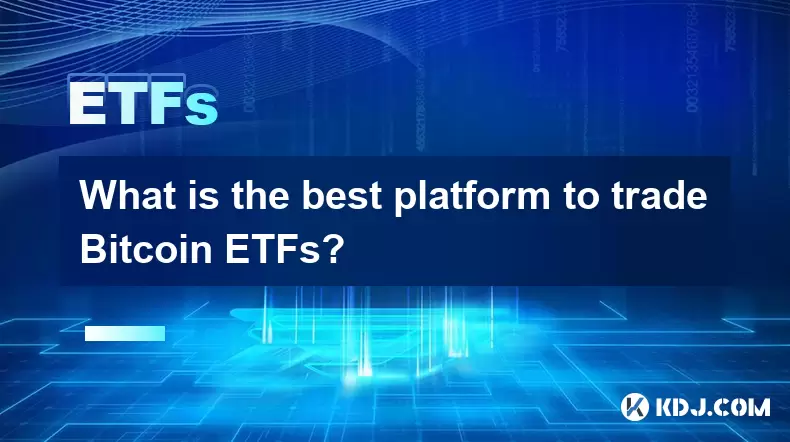
What is the best platform to trade Bitcoin ETFs?
Jul 23,2025 at 04:14am
Understanding Bitcoin ETFs and Their Role in TradingBitcoin Exchange-Traded Funds (ETFs) have gained significant traction among traditional and crypto...
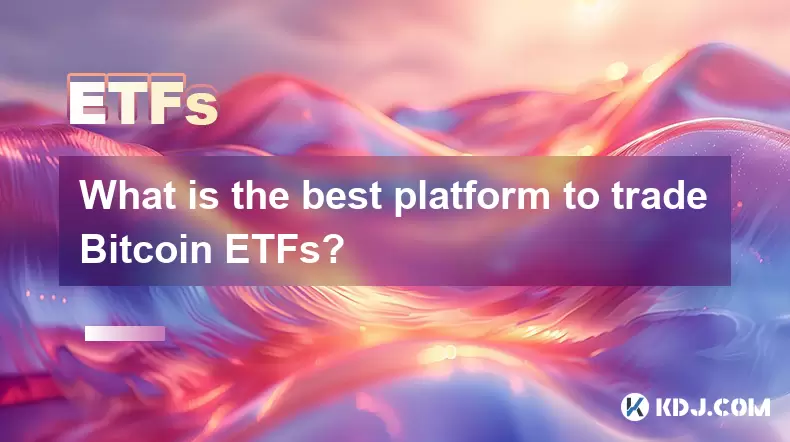
What is the best platform to trade Bitcoin ETFs?
Jul 17,2025 at 03:50pm
Understanding Bitcoin ETFs and Their Role in the MarketBitcoin Exchange-Traded Funds (ETFs) are investment vehicles that track the price of Bitcoin wi...

Will a Bitcoin ETF be available in my 401(k)?
Jul 17,2025 at 10:42pm
What is a Bitcoin ETF?A Bitcoin ETF (Exchange-Traded Fund) is an investment vehicle that tracks the price of Bitcoin without requiring investors to di...
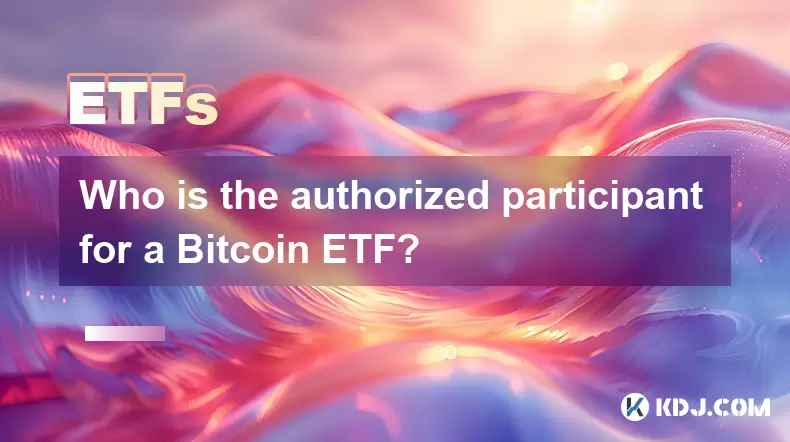
Who is the authorized participant for a Bitcoin ETF?
Jul 18,2025 at 12:42am
Understanding the Role of Authorized Participants in Bitcoin ETFsIn the context of Bitcoin Exchange-Traded Funds (ETFs), an authorized participant (AP...
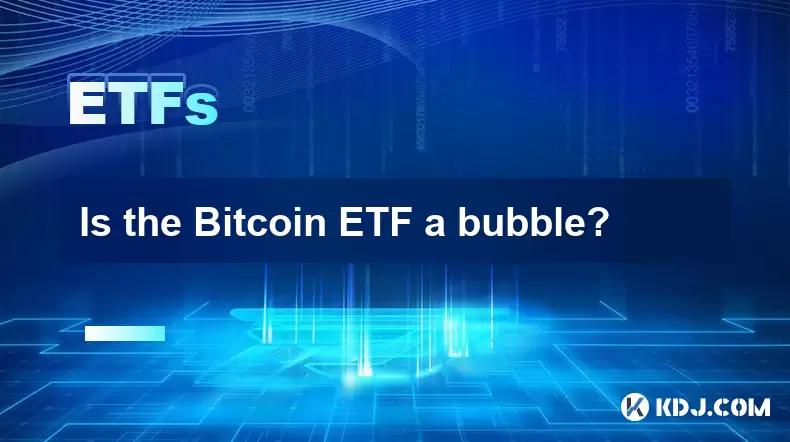
Is the Bitcoin ETF a bubble?
Jul 20,2025 at 06:57am
Understanding the Bitcoin ETF ConceptA Bitcoin Exchange-Traded Fund (ETF) is a financial product that aims to track the price of Bitcoin without requi...
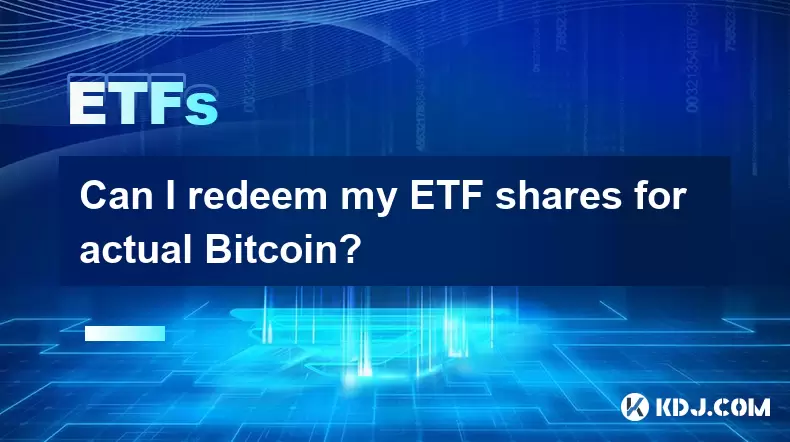
Can I redeem my ETF shares for actual Bitcoin?
Jul 17,2025 at 03:14pm
Understanding ETF Shares and Their Relation to BitcoinExchange-Traded Funds (ETFs) have become a popular investment vehicle for those looking to gain ...

What is the best platform to trade Bitcoin ETFs?
Jul 23,2025 at 04:14am
Understanding Bitcoin ETFs and Their Role in TradingBitcoin Exchange-Traded Funds (ETFs) have gained significant traction among traditional and crypto...

What is the best platform to trade Bitcoin ETFs?
Jul 17,2025 at 03:50pm
Understanding Bitcoin ETFs and Their Role in the MarketBitcoin Exchange-Traded Funds (ETFs) are investment vehicles that track the price of Bitcoin wi...

Will a Bitcoin ETF be available in my 401(k)?
Jul 17,2025 at 10:42pm
What is a Bitcoin ETF?A Bitcoin ETF (Exchange-Traded Fund) is an investment vehicle that tracks the price of Bitcoin without requiring investors to di...

Who is the authorized participant for a Bitcoin ETF?
Jul 18,2025 at 12:42am
Understanding the Role of Authorized Participants in Bitcoin ETFsIn the context of Bitcoin Exchange-Traded Funds (ETFs), an authorized participant (AP...

Is the Bitcoin ETF a bubble?
Jul 20,2025 at 06:57am
Understanding the Bitcoin ETF ConceptA Bitcoin Exchange-Traded Fund (ETF) is a financial product that aims to track the price of Bitcoin without requi...

Can I redeem my ETF shares for actual Bitcoin?
Jul 17,2025 at 03:14pm
Understanding ETF Shares and Their Relation to BitcoinExchange-Traded Funds (ETFs) have become a popular investment vehicle for those looking to gain ...
See all articles

























































































